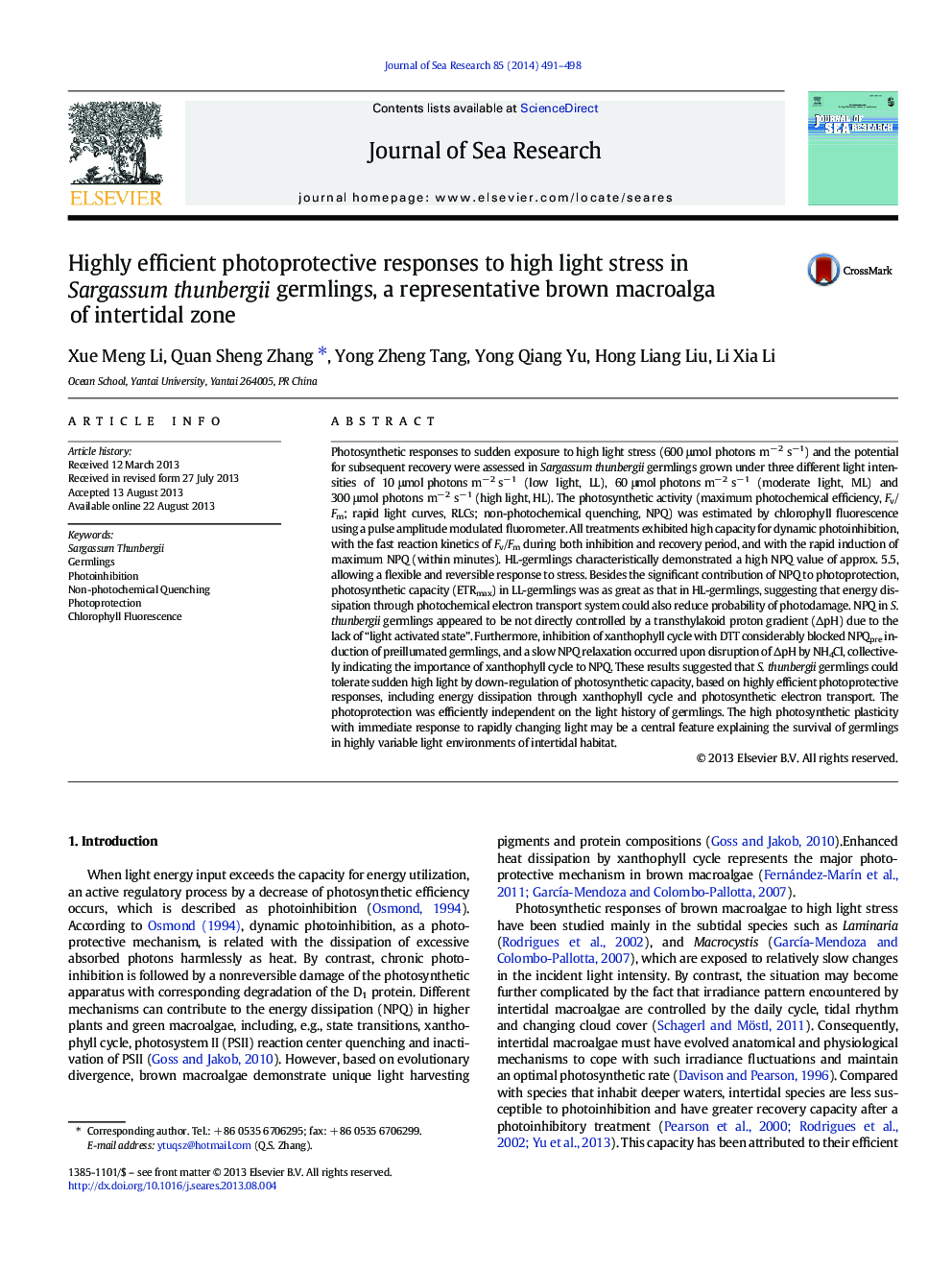| کد مقاله | کد نشریه | سال انتشار | مقاله انگلیسی | نسخه تمام متن |
|---|---|---|---|---|
| 6387448 | 1627489 | 2014 | 8 صفحه PDF | دانلود رایگان |
عنوان انگلیسی مقاله ISI
Highly efficient photoprotective responses to high light stress in Sargassum thunbergii germlings, a representative brown macroalga of intertidal zone
ترجمه فارسی عنوان
پاسخهای محافظت کننده از نورپردازی بسیار کارآمد به استرس نور بالا در گریلینگ سارگاسوم تونبرگی، نماینده قهوه ای ماکروالگا در ناحیه بیرونی
دانلود مقاله + سفارش ترجمه
دانلود مقاله ISI انگلیسی
رایگان برای ایرانیان
کلمات کلیدی
موضوعات مرتبط
مهندسی و علوم پایه
علوم زمین و سیارات
اقیانوس شناسی
چکیده انگلیسی
Photosynthetic responses to sudden exposure to high light stress (600 μmol photons mâ 2 sâ 1) and the potential for subsequent recovery were assessed in Sargassum thunbergii germlings grown under three different light intensities of 10 μmol photons mâ 2 sâ 1 (low light, LL), 60 μmol photons mâ 2 sâ 1 (moderate light, ML) and 300 μmol photons mâ 2 sâ 1 (high light, HL). The photosynthetic activity (maximum photochemical efficiency, Fv/Fm; rapid light curves, RLCs; non-photochemical quenching, NPQ) was estimated by chlorophyll fluorescence using a pulse amplitude modulated fluorometer. All treatments exhibited high capacity for dynamic photoinhibition, with the fast reaction kinetics of Fv/Fm during both inhibition and recovery period, and with the rapid induction of maximum NPQ (within minutes). HL-germlings characteristically demonstrated a high NPQ value of approx. 5.5, allowing a flexible and reversible response to stress. Besides the significant contribution of NPQ to photoprotection, photosynthetic capacity (ETRmax) in LL-germlings was as great as that in HL-germlings, suggesting that energy dissipation through photochemical electron transport system could also reduce probability of photodamage. NPQ in S. thunbergii germlings appeared to be not directly controlled by a transthylakoid proton gradient (ÎpH) due to the lack of “light activated state”. Furthermore, inhibition of xanthophyll cycle with DTT considerably blocked NPQpre induction of preillumated germlings, and a slow NPQ relaxation occurred upon disruption of ÎpH by NH4Cl, collectively indicating the importance of xanthophyll cycle to NPQ. These results suggested that S. thunbergii germlings could tolerate sudden high light by down-regulation of photosynthetic capacity, based on highly efficient photoprotective responses, including energy dissipation through xanthophyll cycle and photosynthetic electron transport. The photoprotection was efficiently independent on the light history of germlings. The high photosynthetic plasticity with immediate response to rapidly changing light may be a central feature explaining the survival of germlings in highly variable light environments of intertidal habitat.
ناشر
Database: Elsevier - ScienceDirect (ساینس دایرکت)
Journal: Journal of Sea Research - Volume 85, January 2014, Pages 491-498
Journal: Journal of Sea Research - Volume 85, January 2014, Pages 491-498
نویسندگان
Xue Meng Li, Quan Sheng Zhang, Yong Zheng Tang, Yong Qiang Yu, Hong Liang Liu, Li Xia Li,
